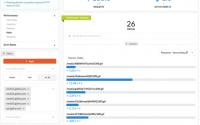Mitigating Mobile App Uninstalls with Remarketing
Mitigating Mobile App Uninstalls with Remarketing
Perhaps the biggest driver of a mobile app uninstall, besides basic app performance, is when the app never makes it into a user’s routine.
We all understand how hard it is for an iOS, Windows or Android app to break through with users. Even after successfully driving an install, app marketers must proactively cultivate a strong and frequent customer relationship. If we don’t, people won’t use the app when we want them to. And even worse, they may uninstall it because it appears to be of minimal relevance to their lives.
Figures estimating the number of downloaded versus used apps vary widely, but it’s clear that only a fraction of apps available on a phone are used with any degree of frequency. According to a 2015 Google study on app usage, the average smartphone user reported 36 apps installed on their mobile devices, but only about 9 used daily.
Another study showed an average of 99 apps per device, but regular usage of only about 16. But what all such studies agree on is that most mobile apps aren’t used all that often, if at all.
It follows, then, that if a cell phone app is not used regularly, it is at much higher risk of uninstall. So getting apps into a user’s regular routine is an important strategy to combat uninstalls.
MOBILE APP RETARGETING AS A PROACTIVE UNINSTALL MITIGATION STRATEGY
Mobile app marketing is undergoing a major shift – from focusing primarily on driving app installs, to something that matters even more – turning those installs into engaged and profitable users.
We’d all like to think that the experiences we deliver in our apps are so compelling that people will try them once and be hooked for life. But most apps need time and multiple launches to demonstrate their value. Driving more iOS and Android app launches and in-app events has been demonstrated to have strongly positive impacts on that process.
Mobile retargeting is a form of advertising that lets mobile app marketers send relevant messages to their customers while they are using other mobile apps or mobile websites. The user sees the ad, clicks on it, and gets directed to the advertiser’s app, sometimes to a specific section or deep link. Some app marketers are starting to put as much emphasis on retargeting as on driving installs, due to its high ROI. Rather than paying several dollars to acquire a new potential user, marketers can spend of fraction of that to re-activate lapsed users, increase conversions, and grow users’ lifetime value. In fact, Apsalar just introduced a feature called SmartTags that makes remarketing even easier by enabling a brand to use one tag to redirect people to up to five different locations based upon their mobile app install status.
Mobile app retargeting enables you to drive engagement across the entire app usage lifecycle. You can define user segments and display targeted ads to each segment, encouraging them to return to your app and ultimately convert into buyers. Whether it’s re-engaging inactive users or driving repeat sales from your best shoppers, retargeting is a versatile strategy that can help you achieve a range of sales and marketing goals.
Research Shows Positive Effects of Remarketing for Controlling Mobile Uninstalls
This Sitepoint article points out the need for reminders and repetitive use in order for an app to stay top of mind. From the piece:
For an app to stay top of people’s minds and sustain a high level of engagement, it must contain one or more of the following traits:
- The problem it solves occurs frequently (daily, or multiple times a week) for its target audience.
- Users are prompted to interact with the app via timely relevant messages.
- By rewarding users through repetition, the app incrementally becomes a habit.
The first option on that list is not really something that an app publisher can use to impact mobile app uninstalls. But the second two are definitely areas where marketing can play a critical role in establishing your app in a person’s ongoing life.
I don’t think it’s possible to overemphasize the importance of habituating usage. Mobile app developers need to have a strategy and plan for doing just that. In addition, users may never fully understand the capabilities and utility of your mobile app creation. The same Google study identified “loss of interest” as a strong driver of app abandonment, which is a measure that includes both uninstalls and simply never relaunching an app.
People lose interest in mobile phone apps for lots of reasons, but it’s important to recognize that if a person only experiences your feature set once, or only tries some of the features, a loss of interest is more likely. A great app is necessary in these circumstances, but not sufficient to creating a long term sustainable business.
The Google study goes on to show that economic incentives are great drivers of mobile app re-engagement.
But so too can be simple reminders and relevant product news.
It’s plain that reminders are a critical part of getting mobile app publishing right. How you remind and reinforce core messages to users should be driven by both the preferences of the users and your business objectives. There are many tools that can be a part of your repertoire. Here are a few of the most popular.
- Push notifications
- In-app message centers
- Email CRM
- Retargeting advertisements
As you formulate your plans, remember that while retargeting can cost a little more than the other tactics, it can also reach virtually all of your users. Push notifications, though, are extremely effective among the 50% or so of individuals that typically accept them when they download an app.
The more detailed the users’ in-app engagement data, the more specific the retargeting ads can be, allowing you to tailor ads to users in different stages of the purchase funnel. The most effective retargeting programs leverage an analytics solution that tracks all post-install behaviors, not just one event type. This provides you with more targeting options for each user, and also allows you to create larger, more sophisticated user segments (groups of users with similar attributes) that update as users take action to enter and leave cohorts.
TAKE A STRATEGIC APPROACH
An effective retargeting strategy begins with an analysis of user attributes, and then segments users based on the action(s) you would like them to take. Using variables such as how recently they used the app, products they’ve purchased or viewed, or subscription status, you can build user cohorts. Once you have defined goal-based user segments, you can create unique ads that are relevant to each cohort and the business objective you’d like them to achieve.


